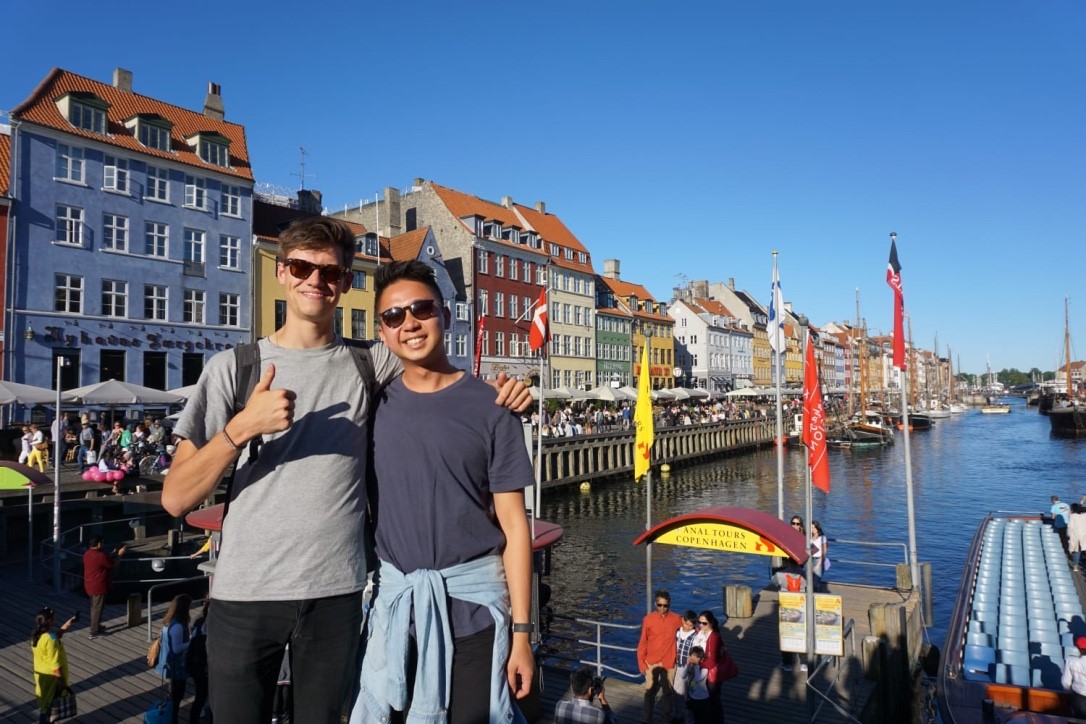EWRE Student Spotlight Olin Marman
Cover image
Olin Marman, is a double degree seeking senior with Environmental & Water Resource Economics B.S. and Economics B.A. Olin reflects on his international travels to Russia and Northern Europe this summer. AREC celebrates Olin, and all of our students creating an engaging and memorable summer break.
Figure 1 - Moscow friends
I spent this summer experiencing an array of the international study options available at the University of Arizona. This included a United States State Department sponsored trip to Moscow with the UA's Russian and Slavic Studies Department, as well as a six-week study abroad in Copenhagen with an Arizona partner institution called DIS. I was abroad a total of eight weeks studying, eating, and making friends in Russia and Northern Europe.
Figure 2 - UA Students at Kremlin
The summer began in Moscow. The University of Arizona led an explorative non-traditional class this spring relating the food cultures of Russia and the Sonoran Southwest which was largely built around an exchange program. Students from Moscow School for Humanities spent a week in Arizona during April, and UA students including myself visited Moscow in May. This trip was an invaluable experience for a number of reasons. The most significant to me was being in the position to experience Russia from a first-person perspective. Russia, and subsequent Russian culture, are constantly involved with American news cycles, political debates, and pop-culture. However, it is rare that an American citizen will visit Russia, despite its importance in our culture. I found that actually being in Russia was vastly different than what I had expected. Prior to the trip, I had formulated the country to be bleak and unfriendly, favoring labor and industry over arts and leisure. I could not have been more wrong. As soon as I landed, I was greeted by kind and helpful University students that acted as personal tour guides for the duration of the trip. These students took our group across all of Moscow, stopping at sites that were both culturally and historically significant. The people in Moscow were exceptionally friendly, directly countering the Russian stereotype I had previously held. I felt perfectly comfortable asking a stranger for directions or a restaurant recommendation, and even befriended young people at some of the events we attended (through my very broken Russian nonetheless).
Figure 3 - Russian farm
The main focus of the trip was to experience Russian cuisine and the culture it represented. My favorite part of this, which was also quite surprising, was the emergence of the locavore movement in Moscow. Locavore has been described as the "hipster foodie" style of cooking, that favors local ingredients and traditional cooking in a young and upper-class environment. It was bizarre to compare Locavore to the "hipster" foods of Tucson, that have also have turned to local ingredients and fresh produce. Despite being completely independent and on opposite sides of the globe, the similarities of the movements in Moscow and Tucson were uncanny. Additionally, we experienced the American influence on Russian cuisine by having lunch at Moscow's flagship McDonalds. The menu items were similar to those available in the United States but the flavors were much richer and heavier. Richness and weight were the two most definitive aspects of Russian cuisine from my experience.
Figure 4 - Downtown Copenhagen
Following Moscow, I flew to Copenhagen, Denmark. With the DIS program, I chose to study Scandinavian entrepreneurship while also interning at a small tech startup. Whereas the Moscow trip was purely a visit, my time in Denmark was spent actually living in the country. I shared a dorm with two other Danish men where we would cook, drink, study, and spend time together. This format was excellent from a study abroad perspective because it allowed me to experience Denmark as a resident instead of a tourist. I attended classes downtown Copenhagen, a city known for its history of forward-thinking design and politics.
Figure 5 - Royal Danish Library
The classes focused on how startup culture exists in the Nordic environment. Interestingly, a disproportionately large amount of tech development occurs in Denmark, Sweden, and Finland. This is largely attributed to the amount of support given to people in these industries by the federal government. People in these countries pay high taxes but in return get free healthcare, university, and funds to conduct research or start new businesses. This negates many of the problems faced in American startup culture, where the idea of working on a project while earning no income in a place like Silicon Valley is daunting. The class placed a special emphasis on the rising importance of cryptocurrency, which is largely centered in Europe.
Figure 6 - Danish woodshop and instructor
We would go on frequent field trips to tech hubs in Copenhagen, and for the final week of class we spent five days touring small and large tech companies in Helsinki and Stockholm. This was my favorite part of the study abroad experience. It was during this trip that we toured the research and development of Microsoft Finland, seeing products that would not be released to public for the next five years. Additionally, we were given the opportunity to sauna next to a beautiful (and cold) Nordic lake. This was a perfect cap on a summer full of new culture, relevant course material, and lasting international friendships.
More info about all Study Abroad opportunities: https://global.arizona.edu/study-abroad
Figure 7 - Cold dip in Finnish lake
Figure 8 - Famous lakes of Copenhagen
Images credits: Olin Marman
Published July 2018


